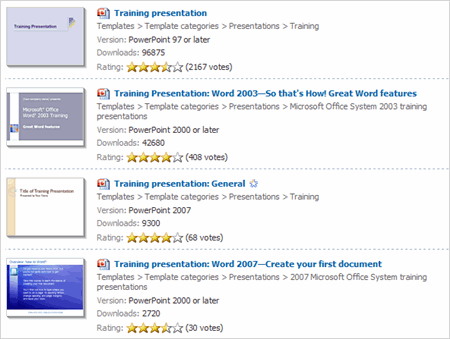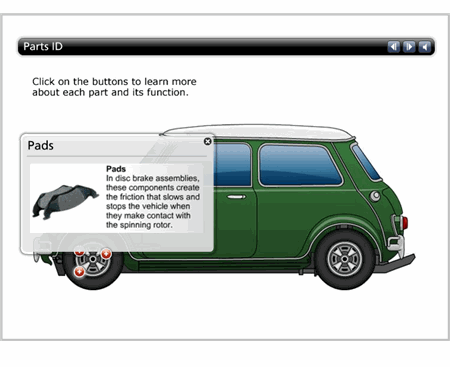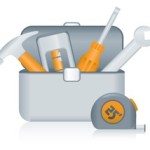[…] Via: Rapid e-Learning Blog […]
5 Simple Ways to Get Started with E-Learning Development
December 11th, 2007
Almost daily I get emails asking how to get started with developing elearning. There’s no substitution for experience. Here are five tips that will help you gain experience and develop the skills to build elearning courses that you can be proud of.
Don’t Go Crazy Trying to Create an Award Winning Course
Start simple. The main goal is to communicate information that will help someone do something better. Microsoft has some really nice starter templates to help you organize your learning project. They even have a generic needs assessment and roll out plan.
Click here to access Microsoft training templates
After you do a few projects, you’ll feel more comfortable branching out from the templates and applying your own unique approach.
Learn from the Experts
To be a successful elearning designer means you have to know something about multimedia, graphic design, instructional psychology, and perhaps a little about Web and Flash technologies.
There are a lot of great experts with books to get you pointed in the right direction. Here are the ones I recommend for those just getting started. They give you a broad overview of what you need to know and all have good visual examples of what to do. The links do go to Amazon and produce a small commission.

-
E-Learning by Design
: I like to recommend this one because it covers all of the basics well.
-
Performance Consulting
: This is a great resource to help you learn how to work with your clients and build a training course that will focus on real results.
-
The Non-Designer’s Design Book
: I like books that explain ideas and then give me good examples. You’ll learn basic design principles and how to organize the content on your screen to create more visual impact.
-
Don’t Make Me Think: A Common Sense Approach to Web Usability: I love this book because you don’t need to read it. The author has good before and after examples. While the book focuses on web usability, most of what he says about web pages applies to elearning, as well.
- E-Learning and the Science of Instruction: A terrific book that explains the research behind why you should and shouldn’t design your course a certain way.
This isn’t an exhaustive list. There are a lot of other good books I could recommend, but this is a good start and covers a lot of the basics.
Feel free to recommend other good books in the comments section.
Play Around with the Software
Compared to building courses in Flash or Authorware, the rapid elearning tools are easy to use. It’s just a matter of getting in there and using them. You really can’t break anything. If you’re not sure where to start, just start with the first drop down item or feature.
For example, I get a lot of questions about the best way to get started with Articulate Presenter. Here’s my answer. Create a simple 10 slide PowerPoint file. Then go to each feature in the drop down menu and use it. The menus are easy to understand and for the most part are self-explanatory. The key is to play around and see what happens.
In addition, try to connect with expert users of the software and show them what you’ve done and ask for opinions. One of the most popular threads in the Articulate Community Forum is one where people share their projects. It’s a great way get feedback and learn to use the software from expert users.
Don’t be Afraid to Experiment
As adults, we tend to inhibit our learning experience because we’re worried that what we do won’t be right. Well, today’s your day of liberation. You have permission to start an elearning project and play around with ideas. Don’t worry about getting it right.
I’ve done enough of these to know that there’s no right or wrong way and you have a lot of latitude in how you design your course. The secret is to practice experimenting with new things.
One of the ways I like to learn is by deconstructing what others have done. I’ll review courses I like and try to replicate them. Replicating good elearning courses helps me think through the project design, which in turn develops the skills I need.
For example, Michael Allen has some great books on building interactive elearning. His book, Guide to E-Learning, comes with a demo CD that has some really good examples in it.
In the image below, you see a screen capture from an Allen course on brake parts. The learner moves the mouse over the label to get information about a specific brake part. This was developed by a Flash programmer.

The good news for you just getting started is that you can get this level of quality with no programming skills and you can build something very similar to the course above in just minutes. In fact, the example below was built in less than 15 minutes using Articulate Engage.
To be engaged in your own learning, look for the types of elearning you’d like to do. Deconstruct the projects and see if you can replicate them. You might not always succeed, but you’ll learn a lot and you’ll really expand your skills.
Take Advantage of the Free Stuff
There are lots of good free resources available that will help you grow in your skills. The key is to use them.
- Stay on top of the industry. In an earlier post, I shared how to leverage web 2.0 technology to increase your skills. By reading blogs and connecting with experts, you will be continually reminded of what’s going on. If you want a good place to start, Gabe, our Director of Customer Support, had a recent post on his favorite learning blogs.
- Become part of the user community. In addition to staying on top of the industry, tap into the community resources for the software you use. As I mentioned earlier, the Articulate Community Forums are very valuable. If you use other software, they probably have their own forums. It’s other users who have figured out best practices to get the software to work for them. Tap into that resource and you can save hours of production time and potential frustration.
- Collect free resources. There are a lot of free resources to help you. In fact, we offer a free ebook that is good for beginners. You can also visit sites like Don Clark’s Performance, Learning, Leadership, & Knowledge. His site is like having an instructional design library at your finger tips.Another site that I like is Making Change. Cathy does a great job showing examples. It’s a good balance to the text heavy, academic information from some of the other sites that are focused on instructional design theory.
These tips are just the beginning. The key for you is to take that first step. Don’t worry about whether what you do is right or wrong. You’ll figure it out as you go.
Take advantage of all of the tips and tricks you get from your peers. And don’t be afraid to ask for help.
Events
- Everyday. Check out the weekly training webinars to learn more about Rise, Storyline, and instructional design.
Free E-Learning Resources
 |
 |
 |
|
Want to learn more? Check out these articles and free resources in the community. |
Here’s a great job board for e-learning, instructional design, and training jobs |
Participate in the weekly e-learning challenges to sharpen your skills |
 |
 |
 |
|
Get your free PowerPoint templates and free graphics & stock images. |
Lots of cool e-learning examples to check out and find inspiration. |
Getting Started? This e-learning 101 series and the free e-books will help. |
33 responses to “5 Simple Ways to Get Started with E-Learning Development”
Good post. I am always looking for good books. The Horton book is one of the best for eLearning.
I wasn’t aware of the Microsoft training templates, thanks for sharing that Tom. We use the template kits that came with our Rapid E-Learning Studio Pro purchase. They are very comprehensive and extremely versatile. I think they were done by the Hortons – who I’m also a big fan of.
Great timing! I have been studying and reading about e-Learning and the various tools for months. I have been trying to learn everything I need to know before going ahead. Of course you never do.
So today, I am just going to jump in and do one or more learning modules. Thanks for the push!
Russ
[…] Experiencing E-Learning Building Experiences through Instructional Design and E-Learning « Daily Bookmarks 12/10/2007 Daily Bookmarks 12/11/2007 December 11, 2007 5 Simple Ways to Get Started with E-Learning Development – The Rapid eLearning Blog […]
Hi Tom – I am always looking forward to your weekly tips/messages. They are very helpful. Question, how do you create a simple presentation like what you did with the car. I use AP, Engage and AO an cannot seem to be able to recreate what you did with Engage (simple “Click here to view demo”). I like how your demo’s just jump into the actual demo.
Thanks, Brent
Tom, I visit the Rapid eLearning blog almost every day. Everything that is written is very helpful to me as an eLearning designer. Including the tips and advices in our elearning job, we are making our customers, as well as, our students very happy. What I like best, is that all your advices are rapid, immediate, with good content and, to the point. They are exactly what the customer needs, and make us think of additional and similar great ideas and solutions.
Thank you Tom for this useful information.
I really enjoy your sentence: “One of the ways I like to learn is by deconstructing what others have done”. I think it also works for me!
Carolina
Good stuff. I like it that I don’t have to know flash but can still get some of the same effects.
How do you keep file size down, when posting to the web?
[…] tarea es acostumbrarse a usar las herramientas“. Y, además, recomienda: “usted sólo céntrese en los aspectos básicos y, a continuación, construiya desde […]
[…] are more books than I can list. However, I did a recent post where I discussed a few that offer a good starting point if you want to get started. What else do you think beginning rapid elearning developers need to […]
Speaking of free stuff: Associate Membership in The eLearning Guild is free, and gives you access to all 280 (as of today) issues of Learning Solutions and The eLearning Developers’ Journal. These publications contain articles written by elearning designers, developers and manager (not by vendor marketing departments), with practical how-to-do-it tutorials, case studies, and basic techniques and strategies for e-Learning. In addition, you can download free eBooks on creating your organization’s e-Learning strategy, on becoming a better online instructor, on producing webinars, and on selecting, implementing, and maintaining learning management systems. The url for the landing page is http://www.elearningguild.com.
[…] 5 Simple Ways to Get Started with E-Learning Development (December 11, 2007) […]
[…] 5 Simple Ways to Get Started with E-Learning Development […]
I have lot to read here.But it very good information.I will try to be on track.If my notebook don’t give hard time.Very good information.Thank you
[…] (From Tom Kuhlman's rapid e-learning blog: http://www.articulate.com/rapid-elearning/5-simple-ways-to-get-started-with-e-learning-development/) […]
[…] 5 Simple Ways to Get Started with E-Learning Development […]
[…] 5 Simple Ways to Get Started with E-Learning Development […]
Thanks very helpful, much appreicated
Hi Tom,
Any tips on how to get into the eLearning field? I have recently completed a specialist certificate in elearning/distance education from University of Wisconsin-Madison. I’m trying to find a entry level job in this area, preferably through higher education. I’m transitioning from Adult & Extension Education to this new education area. Any insights would be greatly appreciated. Thanks.
[…] 5 Simple Ways to Get Started with E-Learning Development […]
i need assistance in writtting my research on E-Learning
[…] Free Training Templates: Microsoft offers a number of free training templates that could serve as a starting point for beginning rapid elearning designers. [original post] […]
[…] This example was created in Articulate Engage'09. It was used in blog post that showed how form-based rapid elearning tools can save time and money. […]
The information in your blog is great information for knowledge acquistion. I enjoy the many articles and links on the subject matter, and tips and tricks. I was first introduced to your blog by my teacher when we were learning how to design e-learning modules. This eCoP shares experiences and information for reflection and thought. Blogs help organize information and each subject is chronicled by date. I like being able to relate to other IDs in the profession and hear their stories of success and what worked for them. This wealth of information can help transform my perspectives of just what is important in instruction design and the best way to approach this field by building on my own reflections.
[…] If someone asks how to learn more of something, we’ll point them to a web site or give them three good book recommendations. The assumption is that with more information things will be better. And that’s what drives a lot […]











0
comments